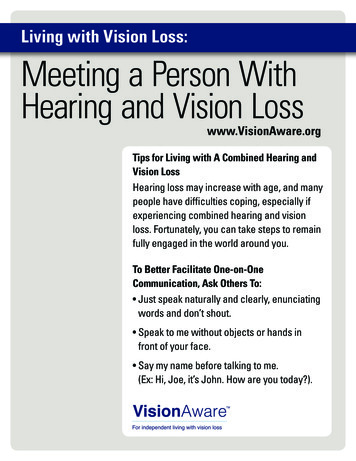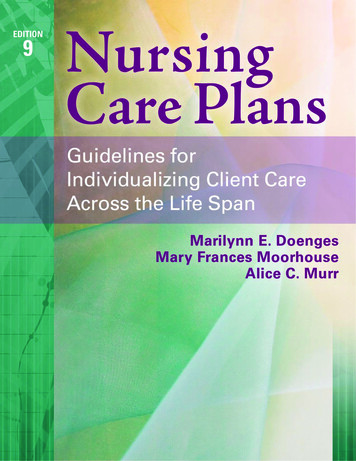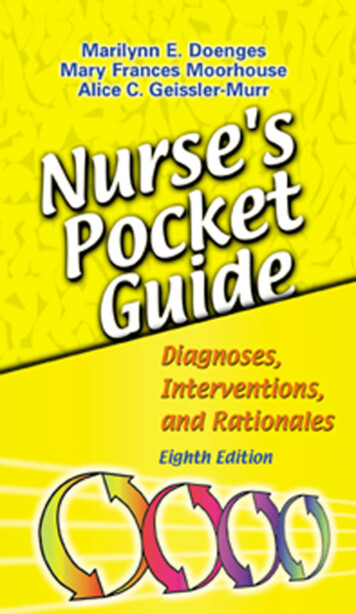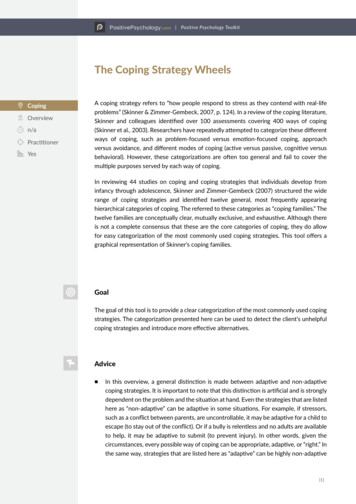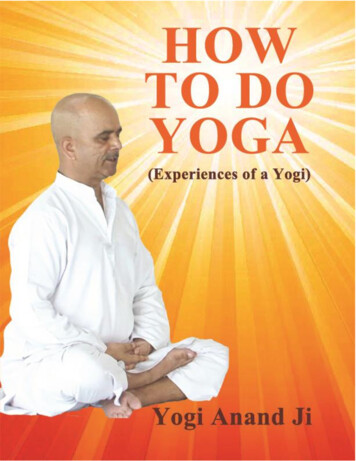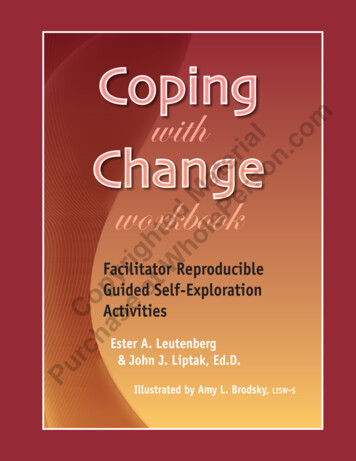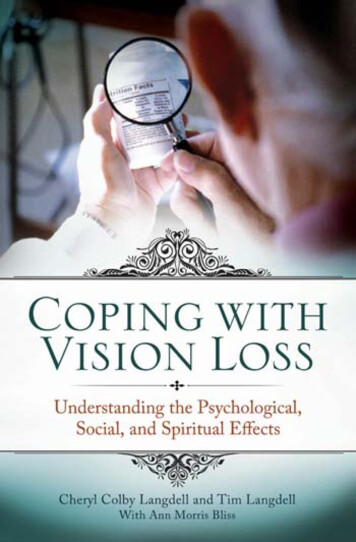
Transcription
Coping with Vision Loss
This page intentionally left blank
Coping withVision LossUnderstanding the Psychological,Social, and Spiritual EffectsCheri Colby Langdell, PhD andTim Langdell, PhD
Copyright 2011 by Cheri Colby Langdell, PhD and Tim Langdell, PhDAll rights reserved. No part of this publication may be reproduced, stored in aretrieval system, or transmitted, in any form or by any means, electronic, mechanical,photocopying, recording, or otherwise, except for the inclusion of brief quotations ina review, without prior permission in writing from the publisher.Library of Congress Cataloging-in-Publication DataLangdell, Cheri Colby.Coping with vision loss : understanding the psychological, social, and spiritual effects /Cheri Colby Langdell and Tim Langdell.p. ; cm.Includes bibliographical references and index.ISBN 978-0-313-34664-4 (alk. paper) — ISBN 978-0-313-34665-1 (eISBN)1. Vision disorders—Psychological aspects. 2. Blindness. 3. Medicine inliterature. I. Langdell, Tim. II. Title.[DNLM: 1. Blindness—psychology. 2. Adaptation, Psychological. 3. Medicine inLiterature. 4. Spirituality. WW 276]RE91.L35 2011617.7—dc222010041475ISBN: 978-0-313-34664-4EISBN: 978-0-313-34665-1151413121112345This book is also available on the World Wide Web as an eBook.Visit www.abc-clio.com for details.PraegerAn Imprint of ABC-CLIO, LLCABC-CLIO, LLC130 Cremona Drive, P.O. Box 1911Santa Barbara, California 93116-1911This book is printed on acid-free paperManufactured in the United States of America
For Sybil, Melissa, and Alene; Sebastian and Anna; and all ourfamily, together with Eva and Kathy, who greatly inspired andassisted us, and for other friends and colleagues who contributed to this book.Dedicated to the blind community and to the memory of Mary,Ed, Rudy, and Ted, with love.
“We see by means of something which illumines us,which we do not see.”–Antonia Porchia, Voices
ContentsAcknowledgmentsix1Introduction12A Brief History of Blindness in World Literature233Original Fiction by the Blind694The Blind Writing about Blindness935The Spiritual Dimensions of Blindness1296Current Insights into Visual Impairment and VisionLoss or Change151Conclusion1637Appendix: List of Useful Links and Resources165Works Cited and Consulted169Index175
This page intentionally left blank
AcknowledgmentsFor their help and support while we wrote this book, we wish to thankFernanda and Paul Schmitt and the staff and children of the Blind Children’s Center in Los Angeles. We also thank the Reverends MelissaLangdell and Alene Campbell for their interest, assistance, and encouragement while we were writing it. And we thank Annina Arthur for heralways brilliant, pertinent suggestions as well as Rahima Nizic-Bonnerfor her spiritual and moral support. We also thank Kathy McCloskey,Dr. Evangelina de Mirande, and Cecelia Moore, who came to therescue.Many thanks, too, to Drs. Ibrahim Jaffe, John Laird, and Randy NurHrabko, to Nura and Bill Mansfield, Rahima Wear, Amina Stader-Chan,and other members of the faculty, staff, and student body of the U.S.H.S.,particularly to Saida, Hamda, Halima, Rahim, Rahima, Lourdes, andother members of the second year class of 2010–11.We thank the faculty of National University for their help and brainstorming, and the English Department faculty at the University of California, Riverside, for their intelligent, invaluable suggestions, and for thebest literary works on blindness, in particular Professors Steven Axelrodfor his help with every aspect of the book and bright ideas, and JohnGanim, for his constructive ideas and positive attitude. Gracious thanks,too, to Dr. Diana Glyer of Azusa Pacific University for setting an inspiring example. Warmest thanks go to Diane Williams, Diane Webb, Karen
xAcknowledgmentsHerrell, Alice Zimmerman Goetschel, Matthew Rogovein, and FrannieSeamans Collie for their friendship and understanding. To Roxy Han andDr. Michael Pangelinan, wellsprings of goodness, we offer our gratitudeas well.We thank the Braille Institute’s Los Angeles Center for their kind andgracious help.We thank the librarians at the Young Research Library at the University of California, Los Angeles, and those at the Rivera Library at the University of California, Riverside.We thank our excellent editor Debbie Carvalko at Praeger for her guidance and her kindness and patience with us, and to Jennifer Boelter, ourfine project manager.Above all, we want to thank Ann Morris Bliss, our wonderful friend,who is the inspiration for this book and an inspiration to us all! Her assistance in research and with every part of the book has better enabled usto write of people’s direct experiences and to empathize more fully withthe experience of blindness. Without Ann this book never would havebeen written.Last we thank the many members of the blind community with whomwe have spoken and been in contact: You have helped us immeasurablyby sharing your lives and writings with us. We hope this book will giveyou courage, confidence, inspiration, and strength and that it will answersome of your questions.Cheri Colby Langdell, PhD, and Tim Langdell, PhDwww.copingwithvisionloss.comSeptember, 2010Pasadena, California
1IntroductionThe blind man carries a star on his shoulderAntonio Porchia, VoicesThis book was written for and is dedicated to the visually impaired andblind, and their friends, family, and colleagues who may wish to gain adeeper insight into their condition. In this book we first present one blindperson’s view of what it is like to be blind, and then we review how blindness has been depicted in world literature. We go on to present a selectionof fiction written by or about the blind and then a selection of nonfiction by blind writers. Finally, we present an overview of blindness in theworld’s religions as well as a brief guide for meditation for blind and visually impaired people, and a chapter on the current state of research oncures for blindness.SOME BASIC FACTS ABOUT BLINDNESSThe technical definition of blindness is having visual acuity of 20/200 orworse in the better eye when corrected with lenses. Twenty-one percentof Americans age 65 and over, or 7.3 million people, have some form ofvision impairment. According to Research to Prevent Blindness, thereare more than 15 million people in the United States with visual impairment, of which 1.3 million people are legally blind. Blindness and visual
2Coping with Vision Lossimpairment particularly affect those age 65 or older, and a leading causein this age group is retinal degeneration.Worldwide, the World Health Organization reports about 314 millionpeople have visual impairments and around 45 million are legally blind.About 87 percent of the world’s visually impaired live in developing countries, and cataracts remain the leading cause of blindness globally. Around82 percent of all visually impaired people are age 50 or older, representingaround 19 percent of the world’s population.THE FIRSTHAND EXPERIENCE OF BLINDNESS:HAVING THE WHOLE CAKE BUT SMALLERPossibly no one re-creates the experience of being blind better thanthe Australian writer, professor, and scholar John M. Hull, who in OnSight and Insight: A Journey into the World of Blindness writes movinglyabout becoming blind, after having suffered from cataracts, as well as acongenital skin condition and asthma. He wasn’t fully blind for his first50 years (Hull 1). His comprehensive philosophical study of the condition and the implications of blindness has a “Foreword” to the blindreader and is an excellent book to read if one is becoming blind. I summarize the most important points here to give a taste of the tone and tenorof his discussions.Hull’s comments in the foreword to this philosophical, phenomenological study are as interesting as they are revealing about what it’s liketo lose one’s sight. He begins by explaining that in 1983, he began keeping a diary both to establish some balance in and control over his life andto record his experiences, dreams, and psychological and emotional responses to his growing blindness. Hull says he started the journal becausehe wanted to make sense of his life as a blind person and resist any urgehe might have initially had to isolate or marginalize himself. He writes itfor those with sight and those without so that everyone might understandmore clearly and fully how it feels to be blind. He was interested in hisown responses to blindness and wanted to observe the changes he experienced in himself throughout the process, to make his life and perspective more comprehensible and thus accessible to his friends and family. Inshort, he wanted to explain everything novel and different about his newlife as a blind man (xi).This noble purpose—to share the experience of and insights into hisown adjustment to the condition of blindness so as to alleviate any distress, confusion, or frustrations others might feel because of ignoranceabout what a blind person goes through—dovetails precisely with the
Introduction3purpose of this book, which is to educate readers about what to expectwhen facing blindness. Both we and Hull hope to give our readers insightinto blindness in order to make the adjustment as smooth and comfortable as it possibly can be. Hull starts with the following explanation of theprocess, presenting a viable, positive approach to the experience: blindness does not in principle “lead to the fragmentation of life” (xii).Losing one’s sight does not resemble losing a limb. One is not disabledin quite the same way, and in fact, as we shall show in this book, one neednot think of oneself as disabled or challenged at all. The blind personis not constantly conscious of any sense of loss; instead, the personalitychanges somewhat, but the person is still the same whole person as before.Hull analogized the individual to a cake that has become smaller. Theperson’s life is still wholly integral, the person still himself or herself; it isjust that the person’s world changes and is more limited spatially (xii). Ofcourse, one still retains the love of friends and family, the love of hobbiesand favorite sports: it is just that ability to engage in all the same activitiesmay be somewhat limited and hampered. As driving a car, for instance,becomes impossible, other activities may arise to take driving’s place.The process of integrating body, mind, and spirit takes time, and howlong it will take depends on many factors—the person’s age at the onset ofblindness, attitude toward the experience, and situation in life (xii). Eachperson’s consciousness manages the reintegration of mind and body afterblindness differently: “This process of reintegration is piecemeal; sometimes there are moments of dawning realization; . . . one feels the . . . gifthas been received and assimilated” (xii). At those times, one feels onehas understood, opened, and accepted the gift of blindness. So the workof assimilation and psychological, spiritual, and mental integration is notarduous, although it is not a process one can rush. The journey is uniqueto each individual. And since it is only a process, not a competition, thereis no time limit or deadline for the reintegration.Hull describes his own process of coming to terms with blindness as,first, through understanding it simply as eye trouble, and then later heunderstood it as a “deprivation of knowledge,” knowing that other senseswould and could compensate for this deprivation. Then he observed atransformation in his body in relationship to the world and saw that theblind do live in a different world, not different in kind but different inscope from the world of sighted people, a world that is whole in itself andalso part of the larger world of those with sight (xii–xiii).His book is a composite of his observations, forming a mosaic and seeking to understand the condition of the blind from a firsthand perspective (xiii). It affords insight into the new consciousness experienced by
4Coping with Vision Lossa blind person that is brought on by entry into the world of blindness,and it shows how that new consciousness is born. Hull draws together hisdreams and hopes, his feelings and experiences: dreams are crucial sinceone first sees changes in the relationship between the conscious mind andthe unconscious mind in dreams (xiii). Next in importance is the “strandof human relationships, since it is in the interaction with others that weknow ourselves.” These are interactions with friends, colleagues, and mostimportant, his own children (xiii). He has a lot of time to interact withhis children and observe how they treat him as a blind person and father.He believes that it is in the study of “the minute particulars” that he hasmost “grown in understanding” of his condition. And observing the wayhis children interpret his blindness has greatly affected his own understanding of it (xii). Without the opportunity to interact with them as afather, he would not have developed such a firm grounding in the worldand a balanced adjustment to his condition. He then detailsa third strand . . . [that is] composed of experiences of the naturalworld. It is the presence of wind, of the rustling leaves of trees, inmeditating upon the inexhaustible beauty of the rain, in being awestruck and terrified by the tumult of the waves on the seashore thatI have built up bit by bit the world of blindness. (xiii)To reimagine and rebuild the world while living with oncoming blindness is quite different in actuality from what one might think it is. Awareof this, Hull asserts,At first it seemed as if thunderstorms without any experience of theflashes of lightning could not possibly be as exciting. This was adeficiency-interpretation. As time went by, thunderstorms becamenot less exciting than before but more so. What the thunder saidwas heard and interpreted in a new way from the state of blindness. (xiii)Last, Hull discusses the benefits of his philosophical, theological, andspiritual meditations in his adjustment to blindness. Christian imageryfrom the Bible was a treasure-house to which he could repair for pictures and stories to embody his life experiences. The Christian traditiondrew him like a magnet and offered him both inspiration from the pastand a way of integrating his own particular experiences and connecting with a universal dimension in them (xiv). His aims, like ours, areto connect with others—the blind and the sighted—and to reach out a
Introduction5helping hand to other blind people, who, he assures us, are as differentfrom one another as sighted people are. Echoing our impulse here as well,he writes,I do not claim to speak for you but only for myself. You . . . know whatblindness is like because you are blind. Perhaps you are reading thisbook in order to discover companionship with someone else who[is blind]. (xiii)Hull’s is a generous spirit. Clearly he wants to help others, just as we do.His book is packed with insights and observations—everything from hisdifferent perceptions as a blind person to anecdotes about how he playedand interacted with his toddlers, how he remembered people’s faces, howhis sense perceptions were altered, and so on.He was born and grew up in Australia and always had trouble with hiseyes, although he did not lose his sight completely until he was about50. He graduated from Melbourne High School for Boys; at the time, hethought he had a vocation for the Methodist ministry, so he enrolled atthe University of Melbourne in 1953, taking an ordinary General Artsdegree (5). But just before the end of his first year at university, “the nowfamiliar dark disc reappeared in my right eye.” He quickly had surgery andwas in the hospital for weeks, teaching himself Braille and reading theBible (5).At home as he recuperated, he discovered that his government scholarship would cover a teacher training course, so he studied for one, earning a diploma in education, specializing in religious education (5). And intwo years, upon finishing what in contemporary America would be calledan associate of arts degree, he was appointed to a position at the CaulfieldChurch of England boys’ grammar school in Melbourne. There he taughtEnglish, history, social studies, and religious education, and he coachedcricket and soccer (6). It appears he was quite active and useful despitefacing blindness.In 1959 he began his studies at Cambridge University (6). As was thecustom in those days, he set sail for England in August 1959 on the SSStrathmore; in those days, each American and Australian university student attempted the grand tour of Europe, and early on, through the end ofthe 1950s anyway, it was customary to sail rather than fly. That was simplymore elegant and less jarring than the international flights, which werestill in the beginning stages. The goal was to see as much of the world aspossible before returning home and putting down roots, possibly neveragain having the chance to travel.
6Coping with Vision LossAfter seeing the sights of London, he took the train to Cambridge,which he loved. These next years were the most formative years of his life.After long months in the Cambridge University Library and vacationshitchhiking across Europe, he experienced a crisis of faith and realized hecould not enter the ministry. He thus determined it would be best to remain in England and pursue a teaching career (6). He also married aroundthis time and accepted a position as a lecturer in divinity in Westhill College of Education in Birmingham, later moving to the University of Birmingham to teach religious education. Eventually, in the mid-1970s, “theforgotten dark shadow made its reappearance” (7) in his right eye, and hewent for an examination by a general practitioner, who could find nothing wrong with his eye. But Hull insisted on seeing a specialist, and theproblem was diagnosed. He had a quick operation, and his right eye wasback to optimal health.A man born in America less than 20 years after Hull had quite a different experience. Harold Krents, born in the United States in 1944 andblind since birth, describes bitterly in his essay “Darkness at Noon” howhe has confronted all the negative assumptions the public makes aboutthe blind: that they can’t hear, can’t speak, and worst of all can’t workor think because they are blind. John Hull seems to have experiencedthe positive benefits of the condition. If Hull, living in England, tastedthe joys of having his four- and then five-year-old son guide him as theywalked to school each morning, Krents’s essay, which was first publishedin the New York Times in 1976, covers officialdom’s negative attitudetoward the blind. His essay gives successive examples of the difficult encounters he has while being admitted to a hospital. There, because he isblind, the admitting staff make the assumption that he needs an interpreter, even though he’s spoken English since birth. Still, Krents writes,“the toughest misconception of all”—and one that was formerly universalfor the blind—“is the view that, because I can’t see, I can’t work” (235).This particular misconception about the blind is the most injurious tothose experiencing blindness or near blindness, since as Krents pointsout, they are routinely discriminated against in hiring, even when suchdiscrimination breaks federal law. When he applied for positions as a lawyer, Krents received over 40 rejections from law firms, “even though myqualifications included a cum laude degree from Harvard College and agood ranking in my Harvard Law School class” (235). When applying forjobs, he was repeatedly told that a blind person could not practice law,“not based on my lack of ability but . . . on my disability” (235). These rejection letters would today make those firms vulnerable to lawsuits; but inthe 1950s through the late 1970s or even into the 1980s, law firms werestill reluctant to hire the blind, even though it was illegal to turn down
Introduction7an applicant on the basis of his or her disability. In fact, in the 1950s, ablind Indian child of the upper class such as Ved Mehta was encouragedto study law (Vedi passim), at a time when virtually all blind Indian professional men were lawyers. At Pomona College, his advisor asked him,“Didn’t you tell me you wanted to become a lawyer or a journalist?” (StolenLight 122). Unfortunately for Krents, however, these experiences becamedefining moments and were some of “the most disillusioning experiencesof my life” (Krents 236). Krents’s unpleasant grilling in an Oxford hospital, described in “Darkness at Noon,” might not have been because hewas blind but because he looked foreign to the admitting officer, who wasan older woman. This Englishwoman had met so few Americans or wasso provincial that she could not understand American English. On theother hand, Mehta, coming into the American workplace 12 years beforeKrents, lived mainly in more cosmopolitan or sophisticated places—orpossibly Americans are just more open to those who speak English withan accent—and eventually got hired as a staff writer for the New Yorkerin 1960, when Krents was just finishing high school (Krents 234). Bornin Australia and teaching in Britain, Hull, who had not been blind sincebirth, worked constantly throughout a long and productive career, eventually attaining a high administrative rank at his university, even thoughhe became legally blind around his 50th birthday. His career was crownedby his appointment to dean of his faculty from 1990 to 1994, and heheld this role in senior university management successfully, enjoying itschallenges.Hull likens his passage into blindness to a crossing of a barrier or boundary; the passage led to his being able to explore in a more creative way thegifts of hearing and touch” (xii).On the other hand, he feels that as he leaves sight he is the recipient ofgrace through his own integrative process in coming to terms with blindness: grace comes as a result of philosophical scrutiny; it “is found in theastonishing powers of the human spirit for healing and rebirth” (xiv).If the past for this blind man is ringed with challenges that today havedisappeared, Hull’s success as a blind person in the sighted world and hisphilosophical scrutiny and theological and spiritual inspiration point theway on the intricate journey a blind person may take toward personalinner freedom.COPING WITH LOSS OF VISIONOne of the first questions Hull asks in the first entry of his diary, on June 1,1983, is similar to one often asked of those learning a foreign language:instead of “How long do you have to study a language before you begin
8Coping with Vision Lossto dream in that language?” he asks, “Does the blind person always dreamin color or does that gradually stop?” (10). Such thought-provoking questions and their answers form the substance and core of the journal he keptfor 12 years, from 1983 to 1991. Although he has been a registered blindperson for nearly 3 years, he says that his dreams are still colorful and pictorial (10). Here carrying on with the theme of dream exploration, heasserts that dreams are the best way to decipher the machinations of thepsyche. He shows that although individuals might have lost their sight,they still possess the imagination to dream in Technicolor: the spirit andpsyche are alive and well, experienced in living color. He comments thathis dreams seem to “lag” behind his own psychic reality by six years (13).In his first years of blindness, he found his psyche began to group thepeople he knew into two groups:There were those with faces and those without faces. It was likewandering around the National Portrait Gallery. Here are rows ofportraits, but here is a blank. You can tell where a portrait used tohang by the outline on the wallpaper, and beneath the space is alittle label giving the name. The people I knew before I lost my sighthave faces but the people I have met since then do not have faces. Iused to find the contrast between the two groups of people disturbedme. I could not relate one set to the other set. I knew how I knewthe first lot—by their faces. How could I ever feel that I really knewthe second lot? (14)In contrast, a year or so after his son Thomas was born, he had a dreamin which he sees his son—looking cheery, robust, a healthy, happy baby—yet Thomas was born 22 days after he lost all sight for good; thus, he’dnever seen him. Probably dreams compensate for the images the blindperson cannot see. They fill in the blanks, as it were.Hull notes that he has clear pictures of the people he knew before hewent blind but that the pictures in his mind of those he associates withon a day-to-day basis are unclear since either he has never seen them or,if they are children, he remembers a younger version of them (14). Heexplains that it is because his relationships with everyday people have“continued beyond the loss of sight, so my thoughts about these peopleare full of the latest developments in our relationships” (14–15). On theother hand, because the relationships with those seldom met or those whoare dead remain static or fixed, likewise their portraits are fixed in time.He recaptures the visage of someone he has known in the past by bringingto mind a certain photograph of that person and mentally looking at that
Introduction9photograph (15).With his wife, Marilyn, and his oldest daughter the opposite began occurring: he slowly began to forget what they looked like,despite his best efforts to remember them (15). Possibly the everyday presence of his wife is compensation.Consequently, there is a happy outcome to this predicament—his wifenever ages in his mind: she remains perpetually youthful in his mentalimage of her (15). Like the virgins and shepherds in Keats’s “Ode to theGrecian Urn,” the spouse of the blind person is fixed in time and neverages in his or her mind. The loved one is, as Keats writes,For ever warm and still to be enjoy’d,For ever panting, and for ever young;And even when the current generation grows old, “Thou shaltremain,” forever young,“Thou shalt remain.” Age can never touch the loved one in theblind person’s inner eye.In one season of the television show Desperate Housewives, Gabriela,married to the blind Carlos, spoke highly of the perks of being a blind man’swife, and other wives and husbands have commented on the comparativeliberation of no longer having their looks judged by their spouses.This issue of those who do and those who do not have faces in hismemory touches Hull more personally, though. He does remember hisoldest daughter well, based on photographs in his mind, but he has veryfew memories of Thomas’s face, and none at all for Elizabeth (also called“Lizzie”), whose portrait is missing from his gallery (15). Of course this isbecause she was born after he became totally blind.Certainly this is a poignant aspect of blindness: to have children andnever be able to see them. Elsewhere, he speaks of how he prides himselfon recognizing Elizabeth when she climbs into his lap and of how his ability to recognize her is very important to them both. So while her portraitis blank, her space in his heart and mind is filled by his love and knowledge that she is just as much his child as are the older ones whom he sawbefore losing his sight completely. Since he can sense and feel her uniquepresence, too, she in fact fills the most important place—the place in thefamily and in his heart.Just as sighted people form an image of someone whom they hear everyday on the radio, so the blind too must have a loosely formed idea of howthose with whom they interact look, even though it is unsubstantiated.Ultimately, Hull states, it makes no difference at all whether or not hecan visualize his three youngest children. While it would be preferable to
10Coping with Vision Lossbe able to see them, he does not think his blindness changes his relationships with them in any way (15). He cherishes them all equally.Once in a while, he reports, images of people with whom he is talking flash before his consciousness so vividly they are almost like hallucinations. He will see someone, say, smartly dressed, in a pin-striped suitand with a full head of hair (16). This picture may then fade and anothermay its place, and his colleague may now be portly, balding, missing someteeth, and wearing entirely different attire (16). All these images couldbecome so arresting that dwelling on them could efface present reality;and occasionally he returns to present reality with a start, aware that he’slost the thread of what his companion is trying to tell him. However,he is surprised to observe that he is just as capable as his colleagues atthe university in interviewing candidates for positions. While sighted colleagues might be able to comment, for instance, that the candidate’s eyesglazed over or that his appearance was untidy, Hull could be picking up onnonverbal cues about the candidate’s character constructed entirely fromwhat he heard in the person’s voice (17). Hence, in effect, Hull believeshis ability to catch nonvisual cues makes up for his inability to make judgments based on seeing faces or clothing.While he is interested to hear the comments of other men he knows onthe looks of a new woman acquaintance, he is most intrigued by the soundof her voice (18). A corollary to this is that, as a result of this process ofpsychic integration of blindness, he is beginning to lose the category ofappearance altogether. He forgets that people do have appearances andhas to remind himself of this (19). Having realized that he does not carewhat others look like, he is then led to wonder what he himself looks like.And of course he is forced to rely on others’ comments to form any ideasabout what he looks like.On a lighter note, early in his blindness, Hull was accustomed to greetothers with “Nice day!” Yet they might either not respond or be startled and puzzled since they considered that the sort of observation onlya sighted person might be able t
2 A Brief History of Blindness in World Literature 23 3 Original Fiction by the Blind 69 4 The Blind Writing about Blindness 93 5 The Spiritual Dimensions of Blindness 129 . 2 Coping with Vision Loss impairment particularly affect those age 65 or older, and a
